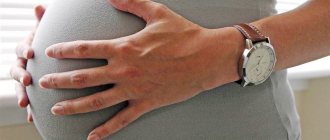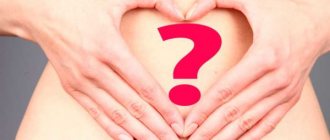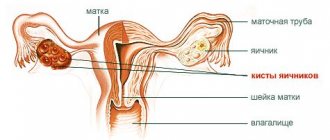Miscarriage occurs as a result of natural termination of pregnancy during the first 20 weeks. Pregnancy is terminated in 20% of pregnant women, while 50% of these women do not even know about their “interesting” situation. A miscarriage can occur before implantation of the embryo, then the fertilized egg is released along with the menstrual flow. Implantation often fail: the pregnancy is terminated almost immediately after implantation, accompanied by bleeding.
Pain after a miscarriage may be associated with the remains of the fertilized egg or endometrium in the uterus.
At the first signs of pain, the doctor prescribes curettage to remove remaining tissue in the uterine cavity. The pain is localized in the lower abdomen, in the lower back. The pain is acute, cutting, tingling in the ovaries, increased body temperature, and profuse bleeding with clots may be observed.
Pain after a miscarriage may be associated with the cause of termination of pregnancy: inflammation, infection, chronic disease in the genital organs, hormonal imbalance. The pain immediately after a miscarriage is cramping in nature, dizziness and mild nausea may occur. This is due to intense contraction of the uterus and its tightening to its normal size.
Pain after miscarriage and adnexitis
Pain after a miscarriage is often caused by the fact that remnants of the endometrium and fertilized egg remain in the uterine cavity. Sometimes, even after curettage , small pieces of endometrium may remain. Dead tissue often provokes the development of inflammatory and infectious diseases of the genital organs. One of the common diseases after a miscarriage is adnexitis.
Inflammation of the ovaries and appendages most often appears after curettage, as well as with incomplete removal of dead tissue and the fetus during a miscarriage. The pain is particularly acute: a cutting, stabbing sensation in the ovarian area, severe nagging pain in the lower back, heavy bleeding. Adnexitis manifests itself in the form of acute pain and during the absence of bleeding. This is due to severe inflammatory processes in the ovaries. Women often experience menstrual irregularities, anovulation, increased body temperature, and decreased mood.
Pain after miscarriage and adenomyosis
Pain after a miscarriage often indicates disorders in the female genital organs. This may be caused by the partial release of dead fetal tissue and uterine mucosa from its cavity. The pain after a miscarriage is spasmodic , cramping in nature, and there is sharp pain in the ovaries and lower back.
Remains of the endometrium, microflora disturbances, and hormonal imbalance often lead to abnormal growth of tissue of the uterine mucosa. This disease is accompanied by the formation of inflammatory foci in places where the endometrium grows into the muscle tissue of the uterus. These lesions provoke extramenstrual bleeding, pain in the lower abdomen throughout the entire cycle and subsequently lead to changes in the shape of the uterus and infertility.
If there is blood, is this normal or not?
After a spontaneous abortion there is always bleeding. This is considered the norm. Bleeding is caused by injury to the vessels of the uterus. At this time, a wound forms in the uterus and the likelihood of infection is higher than ever.
The duration of bleeding depends on the individual characteristics of the female body. The bleeding lasts from five to ten days, if the discharge continues 2 weeks after the miscarriage, then you need to see a doctor. This means that fetal particles remain in the uterus or an infection has entered it.
Clinical picture of pathology during bleeding:
- The patient's performance deteriorates
- Drowsiness
- Urges to feel nauseous and vomit
- Migraine
- Constant fatigue
- My head is spinning
Often, all these symptoms indicate internal hemorrhage and the woman needs hospitalization.
Pain after miscarriage and algomenorrhea
Pain after a miscarriage occurs if there is some kind of disorder. If the miscarriage did not occur completely, then the remaining tissue in the uterine cavity could trigger inflammatory processes and provoke pain in the lower abdomen. Curettage often causes inflammation mucosa , dysfunction of the ovaries and infection. Hormonal disturbances during a miscarriage, combined with inflammation, can change the nature of menstruation, and pain symptoms may become more severe. These disorders often lead to algomenorrhea or worsening of its symptoms.
After a miscarriage, algomenorrhea may become more acute : the lower abdomen may hurt more, the chest may become full and sore. Headaches often appear, and the body feels more weak. Working capacity is significantly reduced. the psychological may worsen throughout the entire cycle: depression, apathy manifests itself, appetite and mood decrease.
Recovery after cleaning
Curettage (cleaning) is a type of surgical intervention that allows you to remove remnants of the epithelium and fertilized egg from the uterus. To recover quickly after this procedure, you need to strictly follow the doctor’s instructions and follow the following recommendations.
Hygiene
For the first one or two days, follow these tips:
Avoid taking too hot baths, saunas or steam baths;- To control discharge, use special pads rather than tampons;
- Take a warm shower 1-2 times a day;
- Wash off with clean water. Using soap or strong antiseptics can lead to infection and cause irritation;
- Avoid douching;
- Do not use gels, ointments and vaginal suppositories;
- Do not swim in the sea, river or other bodies of water.
Sex life
Refusal from intimate relationships extends to 1-2 months - during this period microtraumas and cuts in the vagina will have time to heal. It may be that at first there will be discomfort, or even severe pain, but this will soon pass. If discomfort during sex lasts more than 2 months, consult a gynecologist.
After returning to sexual activity, be sure to use condoms, as there is a risk of becoming pregnant before your usual monthly cycle normalizes. This process usually takes 1 to 1.5 weeks after a miscarriage.
Nutrition
Proper and balanced nutrition will help the body recover faster. Eat more foods rich in vitamins and minerals (especially calcium - up to 200 mg per day). To replenish blood loss, take folic acid supplements and add greens, vegetables and fruits to your diet. Also keep an eye on your water balance - drink at least 8 glasses of water a day. This reduces the risk of thrombosis. Alcoholic drinks are out of the question!
Planning your next pregnancy
You can get pregnant almost immediately after cleansing, but doctors recommend delaying motherhood for at least six months.
During this period, the body will be able to fully recover. If you are experiencing difficulties with your new pregnancy, get a medical examination. For detailed information, see the material on planning pregnancy after a miscarriage.
Psychological rehabilitation
After a miscarriage, most women withdraw into themselves and fall into a state of severe depression. It is absolutely forbidden to remain in this state - it can be dangerous! There is only one solution - talk about the problem with your partner, mother, friend. Of course, it is best to seek advice from a qualified psychologist. A specialist will listen to you, help you cope with negative emotions and instill in you optimism and confidence in the future. If necessary, visit a neurologist. He will prescribe antidepressants and sedatives. Remember, only the right approach will help solve the problem.
Pain after miscarriage and amenorrhea
Miscarriage occurs for a number of reasons, depending on the characteristics of the woman’s body. Almost every abortion at a later stage (6-20 weeks) is accompanied by pain . Every fourth miscarriage provokes menstrual irregularities A sharp hormonal decline, a stressful state of the body, and inflammatory processes after curettage cause amenorrhea - the absence of menstruation.
Amenorrhea after a miscarriage can manifest itself in the form of pinkish discharge With amenorrhea, there is a lack of ovulation . Often, amenorrhea can occur as a result of severe stress to the body after a miscarriage and thus the ovaries rest before a new pregnancy.
Miscarriage at 5 weeks
Miscarriage is a spontaneous interruption of gestation for up to 20-22 weeks. Miscarriages that occur before 12 weeks are called early miscarriages. Losing a pregnancy between 13 and 22 weeks is called a late miscarriage. Miscarriages between 23 and 37 weeks are called preterm birth. In such cases, a viable child is born whose organ systems, with certain support, are able to function independently. The most dangerous condition for a woman is a miscarriage at 5 weeks. What are the risks for a woman if she has a miscarriage at such an early stage? What does it mean when your stomach hurts after a miscarriage? Why does the temperature persist after a miscarriage?
Miscarriage at 5 weeks: causes, symptoms, risks for women, consequences for future pregnancies
Pregnancy is a special condition of a woman when an embryo or fetus develops in her reproductive organs. For pregnancy to occur, the fusion of two sex cells is necessary: a female egg and a male sperm. The average duration of a woman's pregnancy is 40 obstetric weeks, this period begins from the date of the start of the last menstruation. In fact, until the 5th week of pregnancy, a woman may not be aware of her situation. Miscarriage at 5 weeks occurs for a number of reasons, including:
- Genetic disorders are the spontaneous interruption of gestation by the body’s regulatory mechanisms, which reject an obviously non-viable embryo. Genetic disorders are the most common cause of early miscarriages. Such disorders occur due to the fusion of pathological germ cells. Thus, 1 ml of ejaculate contains about 10 million sperm of pathological forms. With age, the risk of maturing a pathological egg increases. Unlike sperm, which is regularly renewed, female eggs are laid in the body at 20 weeks of intrauterine development and are not renewed throughout the woman’s life;
- Inflammatory diseases of the female reproductive system;
- Hormonal imbalance of the body;
- Sexually transmitted infections;
- Features of the physiological structure of the uterus - the presence of synechiae (adhesions) in the uterine cavity, a bicornuate uterus, a septum in the uterine cavity, and others;
- Immunological disorders - autoimmune (a woman’s immune system works against its own proteins), alloimmune (aggressive factors are directed against foreign proteins).
Pain after miscarriage and anovulatory cycle
Pain after a miscarriage is often associated with hormonal disorders and inflammatory processes in the genitals. Dysfunction of the ovaries after termination of pregnancy provokes disruption of the menstrual cycle, irregular bleeding, and anovulation. A common consequence of miscarriage is an anovulatory cycle. This is due to an insufficient amount of hormones from the pituitary gland and hypothalamus to regulate the functioning of the ovaries, the formation of eggs, follicles and the corpus luteum. dysfunction leads to the onset of an anovulatory cycle and the absence of egg maturation. It is the disturbance of ovulation that causes acquired infertility in women who have suffered a miscarriage.
Consequences
In the vast majority of cases, a miscarriage does not affect a woman’s reproductive functions. Only 2-3% of women experience repeated consecutive spontaneous abortions of short term pregnancies. In 85% of cases, subsequent pregnancies and births proceed without complications.
If a woman has had two or more miscarriages in a row, it is necessary to postpone subsequent attempts to become pregnant and seek help from a doctor. After a miscarriage, you should refrain from trying to get pregnant for three menstrual cycles.
Pain after miscarriage and leucorrhoea
Pain after miscarriage and leucorrhoea are associated with termination of pregnancy and the removal of the fetus and membranes. Incomplete removal of the fetus and endometrium leads to inflammation and proliferation of bacteria, which can provoke the development of dangerous diseases. If a miscarriage occurs more than 3 weeks into pregnancy, doctors in most cases prescribe curettage. Residual tissue can cause not only inflammation, but also decomposition and rotting of fetal tissue. This provokes serious consequences with the possibility of blood poisoning. Leucorrhoea after a miscarriage in the early stages is bloody, profuse, reminiscent of menstruation. In this case, it is possible to remove clots and constant acute pain in the lower abdomen. Discharge and pain may last one to three days. The pain after curettage is nagging, dull, and surrounds the lower abdomen. The leucorrhoea is dark brown, not very profuse, and lasts about a week. Profuse bleeding with acute pain in the lower abdomen may be a sign of excessive curettage and damage to the uterine mucosa.
Basics about miscarriage
Spontaneous abortion occurs due to arrest of development and freezing of the fetus inside the woman’s womb. Surprisingly, a frozen fetus may not manifest itself for a long time. Or, conversely, the uterus begins to show signs of fetal death through bleeding and severe abdominal pain. If a woman in labor has absolutely no signs, then it is possible to identify a frozen fetus only during an ultrasound examination. In this case, medical extraction of the fetus from the uterus is performed.









